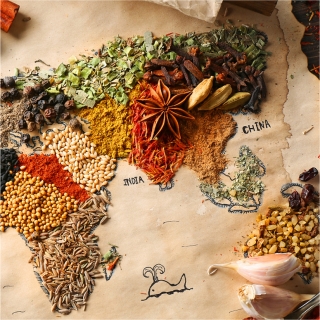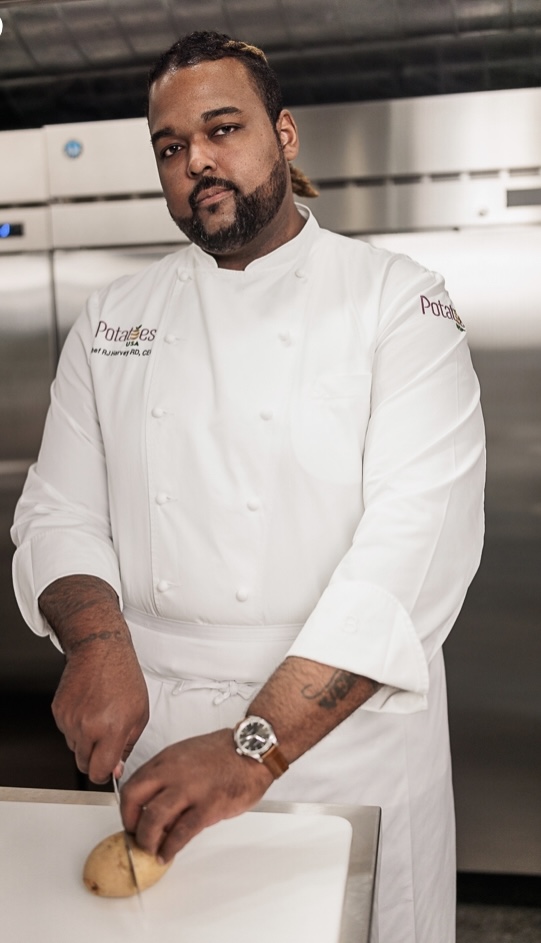
Global Flavor Fusion Teaching Fundamentals
05 March 2024Understanding a specific cuisine’s ingredients drives teaching flavor-mashing secrets and avoids cultural appropriation.
By Lisa Parrish, GMC Editor
Feedback & comments: This email address is being protected from spambots. You need JavaScript enabled to view it.
“I always say fusion can quickly become confusion if one doesn’t have a firm grasp of the cuisine’s why or how.”
– Chef RJ Harvey
Globalization has not only connected technology and trade throughout the world, but it has also linked and broadened palates with flavor mashups no one could have predicted. From smoky and salty to salty and tangy, Indian, Southeast Asian, Korean and African ingredients are merging and creating a melting pot of new delicious dishes.
Even though culinary students may think chefs haphazardly throw random spices together and choose cooking techniques as the wind blows to create a magnificently flavor-layered application, that vision could not be further from the truth. Professional chefs who master global mashups first become near-experts in two, different cuisines and understand each’s ingredients, geography, customs, history, agriculture and more. Proverbially, they learned to walk before they ran.
Professional chefs and global cuisine experts RJ Harvey, CEC, RDN, and culinary director for Potatoes USA, and Kevan Vetter, executive chef and senior director of culinary development for McCormick and Company, have shared their knowledge on fusions and offered guidelines for culinary students learning about fusion. Both chefs agree students can successfully merge two seemingly, unrelated fares, but first they must fully understand a region’s culture, customs and context. It is only then that their flavor mashups can’t truly be successful. According to Chef Harvey, “Their palate is their strongest tool in the kitchen. They should take care of it, train it and learn how to use it.”
 Chef RJ Harvey
Chef RJ Harvey
Fusion is an interesting concept, the melding of cuisines can create exciting concepts but they can also lead to epic fails and cultural appropriation.
It’s incredibly important to understand the ingredients in a specific cuisine as well as the proper cooking techniques before attempting to meld them with another. I always say that fusion can quickly become confusion if one doesn’t have a firm grasp of the cuisine’s why or the how.
With that said, one shouldn’t be afraid to experiment while learning and studying. I recommend trying flavors from countries that share borders to start. Many of these countries share ingredients and cooking techniques. A world of wonderment and complexity to one’s culinary repertoire is opened when a solid grasp of flavor profiles and techniques is established. That’s why it’s important to know the flavors different ingredients contribute to a dish.
Students might try using coconut vinegar or tamarind to brighten dishes that traditionally may use lime juice, or they could explore different chilies to find the right flavor balance that suits them. Study and taste different soy sauces and fish sauces from various countries to understand the nuances between them. Students could try making their own condiments and sauces using the balance equation of sweet, salty, sour, spicy, bitter, and umami. They should try these condiments on roasted, fried, stir-fried, smoked, charred, grilled, and steamed foods and learn how the flavors benefit different cooking methods.
Students should also learn and research why different cultures use certain ingredients more than others. The Northern Thailand cuisine is vastly different than Southern Thailand cuisine, with more chilies and grilled seafood items in the south and more stews and heavier meaty dishes in the north. Seek to understand what grows where and why.
There is truth in the adage: what grows together, goes together. An example is coconut milk and seafood/shellfish and another is roasted chestnuts and pork from pigs who feed on them. Yet another example is pairing sweet fruits such as pineapple with chilies.
It is important to note while some cuisines have overlap such as Thai, Cambodian, Laotian and Vietnamese, others that seem similar at first blush are very different such as Korean and Japanese cuisines. When students understand what flavors flow together, their repertoire in the kitchen becomes extremely versatile.
It is then, after gaining an understanding of what ingredients go together and why, they can try fusing chilies from different cuisines into recipes from others, swapping out citrus and vinegars, and mixing Asian-inspired fermented foods with dishes from around the globe. For example, kimchi, a fermented spicy cabbage from Korea, and pork braised collards from the southern US are one of my favorite pairings. Students may swap sauces and condiments. They should have fun tasting, then taste more, and again keep tasting. Their palate is their strongest tool in the kitchen. They should take care of it, train it and learn how to use it.
 Kevan Vetter
Kevan Vetter
Global fusion has come from many influences over time. Some fusions have evolved from conquering empires invading and ruling over another for an extended time period and some come from immigration/migration as the world population shifts and flows. Flavor fusion occurs in a variety of ways, the necessity of having to adapt to using ingredients to ensure food is being put on the table to feed a family; curiosity about a new ingredient or technique and exploring how it has been used in the past; and exploring new ways to use an unfamiliar ingredient.
A great example of flavor fusion that we’ve seen in the US is Vietnamese Cajun. It predominately has been found in the Gulf Coast regions of Texas and Louisiana. There has been an uptick in fusing the flavors of the Gulf Coast with flavors of Vietnam because of a high number of Vietnamese families moving into the area. The flavor mashups can be seen in dishes such as seafood boils that combine gulf seafood with the flavorful and vibrant aromatics of Vietnam such as lemongrass, ginger, citrus and fish sauce. While these flavor combinations began in the 70s, there has been much more awareness of this fusion of flavors over the past few years. In 2023, McCormick’s 23rd Edition Flavor Forecast declared Vietnamese Cajun as our Flavor Of The Year and introduced a seasoning blend and recipes to help chefs and cooks bring this flavor fusion to life in their own kitchens.
